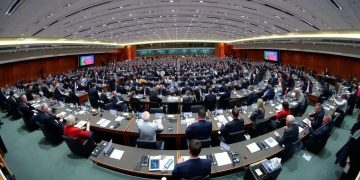Market outlook analysis: Bessent’s insights on trade

Anúncios
Argentina faces significant economic challenges, including high inflation and debt, while also possessing opportunities in agriculture and technology that can help drive recovery and growth.
Market outlook analysis: Bessent weighs in on trade to provide insights into how these elements affect investments. Have you pondered how trade policies shape currency values and economies? Let’s dive into this dynamic landscape.
Understanding the current trade landscape
Understanding the current trade landscape is essential for grasping how global economies interact. Trade dynamics influence everything from job creation to inflation rates. Various factors play a role in these dynamics, impacting numerous stakeholders.
Key Factors Affecting Trade
There are several key factors to consider when analyzing the trade landscape. These factors highlight how interconnected economies are in today’s global market.
- Tariffs: These are taxes imposed on imported goods, affecting pricing and consumer choices.
- Trade Agreements: Agreements between countries can facilitate smoother trade flows and economic cooperation.
- Currency Fluctuations: Changes in currency values can make exports cheaper or more expensive, directly influencing trade volumes.
- Political Stability: Countries experiencing political turmoil often face challenges in maintaining healthy trade relationships.
As we analyze these elements, it’s interesting to note how they compound and affect market outcomes. For instance, rising tariffs can strain relations between trading partners, resulting in retaliatory measures. This interconnectedness means decisions made in one country can have ripple effects across the globe.
Current Trends
Examining current trends provides insight into where trade is headed. With technological advancements, online commerce has changed the game. Businesses are no longer limited to local markets; they can now reach customers worldwide with just a click.
Additionally, geopolitical issues like the tensions between major economies have also led to a reevaluation of trade practices. Companies are exploring more sustainable practices in their supply chains to mitigate risks associated with overseas manufacturing. It’s important to stay informed about these changes, especially for investors and policy-makers.
By understanding these shifts in the trade landscape, stakeholders can make more informed decisions. With global trade becoming more complex, a thorough analysis of trends and factors will provide a clearer picture of future opportunities.
Bessent’s take on Powell and monetary policy

Bessent’s insights on Powell and monetary policy reveal important truths about economic management. Understanding how monetary policies shape the economy helps in grasping current market conditions.
Impact of Federal Reserve Decisions
The Federal Reserve plays a crucial role in determining interest rates and controlling inflation. Bessent emphasizes how decisions made by Powell and his team can influence lending rates and spending habits.
- Interest Rate Changes: Adjustments to interest rates can either stimulate or slow down economic growth.
- Inflation Control: Effective monetary policy aims to keep inflation within a desired range, ensuring price stability.
- Market Reactions: Investors closely monitor these changes, as they can significantly affect asset prices.
When the Federal Reserve raises interest rates, consumers may borrow less. This reduces overall spending in the economy. Conversely, lowering interest rates can encourage borrowing and increase consumer spending. Bessent’s analysis highlights how these shifts are crucial for businesses and investors.
Future Outlook
Looking ahead, Bessent suggests that Powell’s approach will need to adapt to changing economic conditions. With ongoing global challenges, such as supply chain issues and geopolitical tensions, monetary policy might need to remain flexible.
Furthermore, the interplay between fiscal policy and monetary policy will also shape economic outcomes. If governments implement stimulus measures while the Fed tightens monetary policy, the resulting effects on the economy could be unpredictable.
Understanding Bessent’s take provides valuable context for navigating future economic landscapes, especially as market conditions evolve. As investors watch closely, the strategies adopted by Powell may influence investment decisions profoundly.
The impact of the dollar on global markets
The impact of the dollar on global markets is significant and far-reaching. As the world’s primary reserve currency, the U.S. dollar influences everything from import prices to international investment strategies.
Strength of the Dollar
When the dollar is strong, imports become cheaper for U.S. consumers. This often leads to increased purchasing power. However, a strong dollar can also make U.S. exports more expensive for foreign buyers.
- Export Challenges: Higher prices on American goods can reduce demand abroad.
- Import Benefits: It facilitates cheaper consumer goods and materials for businesses.
- Investment Attraction: A strong dollar often attracts foreign investment into U.S. markets.
Fluctuations in the dollar’s value can create ripples across global financial markets. Many countries depend on U.S. imports for essential goods, and changes in dollar strength can impact local economies deeply.
Global Economic Relationships
The dollar’s influence extends to how countries conduct trade. Many international transactions are priced in dollars, which affects global trade balances. For instance, countries that hold large reserves in dollars may find themselves at the mercy of fluctuations.
Additionally, nations may experience inflation or deflation linked to dollar movements. If the dollar strengthens, countries with weaker currencies may face higher import costs. This situation can lead to economic strain and adjustments in their monetary policies.
Furthermore, nations often monitor dollar trends to maintain competitive exchange rates. If the dollar declines, countries may benefit from cheaper exports, thus boosting their economies. Understanding these dynamics is crucial for investors and policymakers as they navigate the ever-changing global market landscape.
Argentina’s economic challenges and opportunities

Argentina’s economic challenges and opportunities paint a complex picture. The country has faced numerous issues, including inflation and debt, while also possessing unique assets that can drive growth.
Current Economic Challenges
One of the most pressing problems is inflation. It has soared in recent years, reaching alarming levels. This situation hurts purchasing power and affects everyday life for many Argentinians.
- Currency Devaluation: The Argentine peso has lost value, making imports more expensive.
- High Debt Levels: Argentina carries significant debt, leading to negotiations with international creditors.
- Unemployment Rates: Many citizens struggle to find work, which exacerbates social issues.
Another challenge is the reliance on agricultural exports. While Argentina is a major player in the global agricultural market, fluctuations in commodity prices can impact the economy significantly. For instance, low prices can lead to reduced revenue, affecting public services and infrastructure.
Opportunities for Growth
Despite these hurdles, Argentina harbors several opportunities that could promote economic recovery. The country is rich in natural resources, particularly in agriculture and mining. Strengthening these sectors can create jobs and boost exports.
Another significant opportunity lies in technology and innovation. As global demand for tech solutions rises, Argentina’s growing tech scene can position the country as a competitive player. Emerging start-ups in Buenos Aires are becoming increasingly recognized on the global stage.
Furthermore, policy reforms aimed at attracting foreign investment could unlock new avenues for growth. Establishing a stable economic environment is essential for fostering business confidence and reversing the current trajectory.
In summary, Argentina faces significant economic challenges, such as inflation and high debt levels, which affect its citizens daily. However, the country also has great opportunities, especially in agriculture and technology sectors, that can drive its recovery. By leveraging its natural resources and fostering innovation, Argentina can build a stronger economy. It is essential for policymakers to create a stable environment that encourages growth and attracts foreign investment, paving the way for a prosperous future.
FAQ – Frequently Asked Questions about Argentina’s Economic Challenges and Opportunities
What are the main economic challenges facing Argentina?
Argentina’s main challenges include high inflation, significant debt levels, and unemployment, affecting everyday life for its citizens.
How does inflation impact the average Argentine citizen?
Inflation reduces purchasing power, making it harder for citizens to afford basic goods and services.
What opportunities exist for economic growth in Argentina?
Argentina has opportunities in its rich natural resources, particularly agriculture, and a growing technology sector that can drive recovery.
Why is foreign investment important for Argentina’s economy?
Attracting foreign investment can help stabilize the economy, create jobs, and facilitate growth in key sectors.






